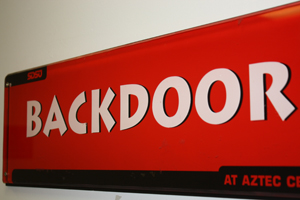Preserving Aztec Center's Musical History
Anthropology professor Seth Mallios is preserving a psychedelic mural.

The Backdoor mural is a sight to behold. At almost nine feet high and 14 feet wide, it depicts a psychedelic rock band composed of what appears to be Aztec warriors decked out for a '70s-style concert.
“Half Kiss, half Aztec warrior,” is how SDSU Department of Anthropology Chairman Seth Mallios described the characters in the mural. “The colors are so bright."
There’s the lead singer, flanked by a host of glyph-like characters playing guitar, bass, keyboard and an entire horn section including saxophone and trombone players.
“The lead singer has these sort of Kiss-like shoes — the elevator shoes,” Mallios pointed out. “The Aztec imagery with all this '70s rock stuff — it’s just really fun."
The mural was completed January 27, 1976, and is signed in the lower right corner by the principal artist, Arturo Anselmo Roman.
“He was teaching a class in Chicano mural art and he and his students did this,” Mallios said. “They dedicated it to the god of music."
'Where Spinal Tap got lost'
Located in a seldom-used hallway in the lower level of Aztec Center, the mural has always gone largely unnoticed by most San Diego State students during its 35 years of existence. That’s because it’s down a side passageway near the rear stage entrance to the Backdoor, a small but formerly popular concert venue that hosted some of the greatest musical artists of the late '60s through the '90s.
Most concertgoers who came in the venue’s front entrance never even knew the mural was there, but every band that took the stage passed directly by it.
“I just love the sort of caverns you have to go through to get to this venue — it reminds me of where Spinal Tap got lost," says Mallios, referring to the fictional heavy metal band from the mockumentary, This is Spinal Tap.
"They (bands) would come down here and circle around and then enter the stage,” Mallios explained. “So all the bands who were playing here saw this and saw how cool it was to have all these Aztec rockers. It looked really cool."
According to research by Mallios and his associates, among those who likely laid eyes on the mural were Jimmy Buffet, who has played San Diego State more than any other artist, the Ramones, Patti Smith, REM, Metallica, Ravi Shankar, Echo & the Bunnymen, Talking Heads, Jane’s Addiction.
“There’s this huge untold story of live music at San Diego State," Mallios said. “The Backdoor is so important because this is the place where all these bands played right before they got big.”
"I look at this mural as sort of the rookie card for music. If you're collecting baseball cards you want the rookie card because it represents the player before they became big. Well, we had these bands right before they were huge that came here and were playing to a couple hundred students at the Backdoor. In my mind, there's something very authentic about the early days of those bands."
Rescued from the wrecking ball
That’s why, when Mallios learned that Aztec Center would be demolished to make way for a new student center, he asked Associated Students leaders to fund a mural preservation project. While AS chose not to fund the project, Mallios raised $15,000 to preserve it.
He called upon noted conservator, Gary Hulbert, to preserve the mural. This month, Hulbert is splitting his time between saving the Backdoor mural and working on a project at Hearst Castle. He is familiar with SDSU after working with Mallios to preserve the Hardy Tower murals which are now displayed in the campus library.
The money that Mallios raised with the help of the library is only enough to remove the mural and store it. Additional funding will be required to restore it and move it to a new location.
“Ultimately, I would like to see the mural displayed with a rock ’n’ roll exhibit in the library or I think it would be really cool to have it in the alumni center,” Mallios said.
From mosh pit to meeting space
These days, the Backdoor plays a decidedly different role in student life. What used to be a mosh pit is now a meeting space.
On a recent evening, the venue played host to a gathering of SDSU Campus Republicans. Live bands have been replaced by iPods as the primary source of music, and most students who venture in likely have no idea what the room used to mean to generations of their predecessors. Few, if any, are aware of the story behind the lively wall art just outside and down the hall — if they have ever even seen it.
But soon it will all be gone, except for a single, colorful nine-by-14-foot mural rescued as a reminder that live music once played a major role on campus and that San Diego State played a big part in the careers of some of rock’s brightest stars — before they were big.




